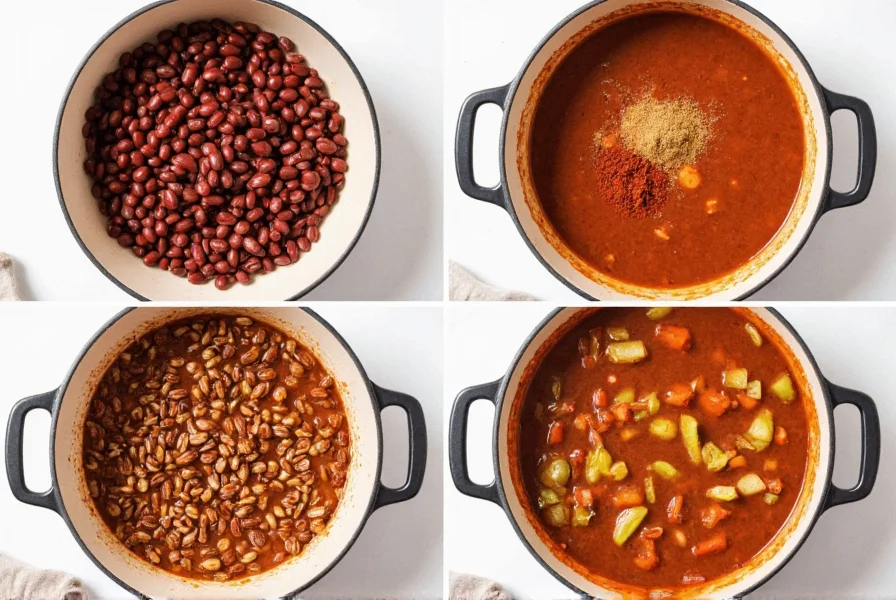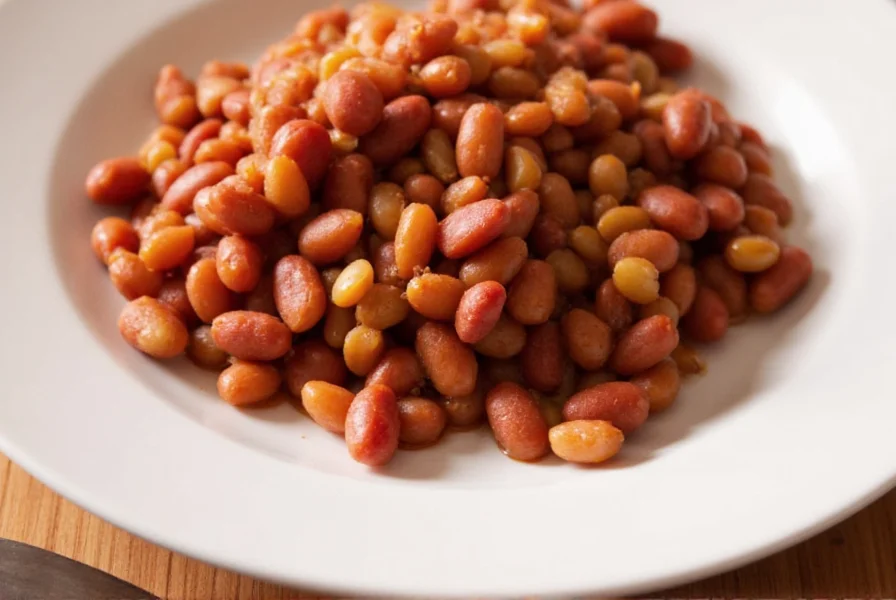Creating perfect chili beans requires understanding the balance between spices, cooking time, and bean texture. Whether you're using canned beans for convenience or cooking dried beans from scratch, the key to exceptional chili beans lies in layering flavors and allowing sufficient simmering time for the ingredients to harmonize.
Essential Ingredients for Flavorful Chili Beans
The foundation of great chili beans starts with quality ingredients. While regional variations exist, these core components create a balanced flavor profile that satisfies most palates:
| Ingredient | Quantity | Preparation Notes |
|---|---|---|
| Cooked pinto or kidney beans | 4 cups (about 2 cans) | Rinse canned beans thoroughly to remove excess sodium |
| Yellow onion, finely diced | 1 medium | Yellow onions provide the best flavor foundation |
| Garlic cloves, minced | 3-4 | Fresh garlic essential for authentic flavor |
| Crushed tomatoes | 1 (15 oz) can | Fire-roasted tomatoes add depth |
| Chili powder | 2-3 tablespoons | Adjust to preferred heat level |
| Ground cumin | 1-2 teaspoons | Essential earthy flavor component |
| Olive oil or vegetable oil | 2 tablespoons | For sautéing aromatics |
| Beef or vegetable broth | 1 cup | Low-sodium preferred |

Equipment You'll Need
Before beginning your easy homemade chili beans recipe, gather these basic kitchen tools:
- Medium to large saucepan or Dutch oven (3-4 quart capacity)
- Wooden spoon or heat-resistant spatula
- Sharp chef's knife
- Cutting board
- Measuring cups and spoons
- Can opener (if using canned beans)
Step-by-Step Instructions for Perfect Chili Beans
Follow these detailed steps for the best way to cook chili beans from scratch that maintain ideal texture while developing deep flavors:
- Sauté aromatics: Heat oil in your pot over medium heat. Add diced onions and cook until translucent (about 5 minutes). Stir in minced garlic and cook for 1 minute until fragrant.
- Add spices: Immediately add chili powder, cumin, paprika, and oregano. Stir constantly for 30 seconds to toast the spices and release their essential oils.
- Incorporate tomatoes: Pour in crushed tomatoes and broth, stirring to combine with the spice mixture. Bring to a gentle simmer.
- Add beans: Gently fold in the cooked beans, being careful not to break them. For authentic chili beans texture, reserve about 1/2 cup of beans to mash later.
- Simmer: Reduce heat to low, cover partially, and simmer for 30-45 minutes, stirring occasionally. The longer it simmers (up to 90 minutes), the more the flavors will meld.
- Thicken sauce: After 25 minutes of simmering, mash the reserved beans with a fork and stir them back into the pot. This creates a naturally thicker, creamier sauce that clings to the whole beans.
- Season: Taste and adjust salt, pepper, and additional spices as needed. A splash of apple cider vinegar or lime juice at the end brightens the flavors.
Pro Tips for Exceptional Chili Beans
These professional cooking techniques transform simple chili beans into something extraordinary:
- Bean selection matters: Pinto beans create a creamier texture while kidney beans hold their shape better. For the best chili beans for beginners, try a 50/50 mix of both.
- Don't skip the spice blooming: Cooking spices in oil for just 30 seconds dramatically improves flavor development compared to adding them directly to liquid.
- Acidity balance: If your chili beans taste flat, add acid gradually—a teaspoon of vinegar or lime juice can transform the flavor profile.
- Texture control: For restaurant-quality chili beans texture, mash 10-20% of the beans to create a natural thickener without needing flour or cornstarch.
- Resting time: Chili beans taste significantly better after resting for 15-20 minutes off heat, allowing flavors to fully integrate.

Popular Variations to Customize Your Chili Beans
Once you've mastered the basic technique for how to make chili beans, experiment with these delicious adaptations:
- Smoky chipotle version: Add 1-2 minced chipotle peppers in adobo sauce and 1/2 teaspoon smoked paprika for deep, complex heat.
- Tex-Mex style: Include 1 diced bell pepper with the onions and add 1 teaspoon of dried Mexican oregano for authentic regional flavor.
- White bean chili: Substitute cannellini beans and green chilies for a lighter, creamier alternative to traditional chili beans.
- Meat-enhanced: For non-vegetarian options, brown 1/2 pound of ground beef or turkey with the onions for hearty chili beans with meat.
- Instant Pot method: For quick chili beans in 30 minutes, use an electric pressure cooker with 1 cup less liquid and cook on high pressure for 8 minutes.
Storage and Reheating Guidelines
Proper storage ensures your chili beans maintain quality and flavor:
- Refrigeration: Store cooled chili beans in an airtight container for up to 5 days. The flavors often improve on day two.
- Freezing: Portion into freezer-safe containers with 1-inch headspace. Properly frozen chili beans maintain quality for 3-4 months.
- Reheating: Gently warm on stove over medium-low heat, adding a splash of broth or water if needed. Microwave reheating works well but may require stirring every 60 seconds.
- Revitalizing leftovers: Add a squeeze of fresh lime juice and a pinch of cumin when reheating to refresh flavors that may have mellowed during storage.
Frequently Asked Questions
Can I make chili beans without tomatoes?
Yes, you can create tomato-free chili beans by substituting 1 cup of roasted red peppers blended with 1/2 cup of broth for the tomatoes. This maintains the necessary liquid content while providing a different flavor profile that works particularly well with white bean variations.
How do I prevent my chili beans from becoming too watery?
To achieve the perfect chili beans texture, simmer uncovered for the final 15-20 minutes of cooking. Alternatively, mash 1/4 to 1/2 cup of the beans and stir them back into the pot, which naturally thickens the sauce without altering flavor. Avoid adding excess liquid beyond what's specified in reliable chili beans recipes.
What's the difference between chili beans and refried beans?
Chili beans feature whole beans in a flavorful tomato-based sauce with spices, while refried beans are cooked beans mashed and fried with fat (traditionally lard). Chili beans maintain distinct bean texture throughout the dish, whereas refried beans have a smooth, spreadable consistency. Both can use similar spices, but chili beans contain more liquid and vegetable components.
Can I use dried beans instead of canned for chili beans?
Absolutely. For the best way to cook chili beans from scratch using dried beans, soak 1 pound of beans overnight, then simmer in fresh water until tender (1-2 hours). Drain, then proceed with the recipe, reducing added liquid by 1 cup since dried beans absorb more moisture during cooking. This method yields superior flavor and texture compared to canned beans.
How can I make my chili beans spicier without overwhelming heat?
For balanced heat in chili beans, add 1/4 teaspoon of cayenne pepper along with your other spices, or include one finely diced jalapeño (seeds removed) when sautéing onions. You can also stir in a few dashes of hot sauce during the last 10 minutes of cooking. Remember that heat intensifies as chili beans sit, so adjust cautiously and allow flavors to develop before serving.











 浙公网安备
33010002000092号
浙公网安备
33010002000092号 浙B2-20120091-4
浙B2-20120091-4